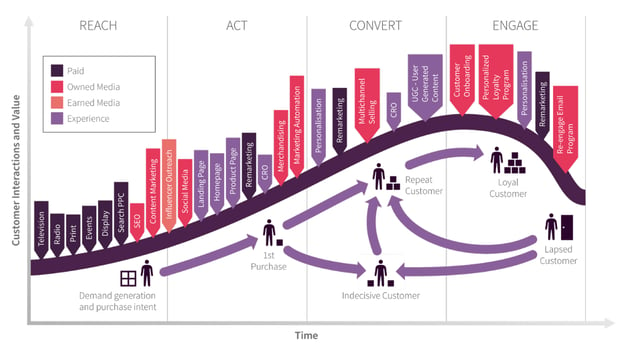
There are lots of different channels in online marketing, let alone marketing in general. It’s easy to treat different each marketing channel as a separate silo,
but if you do this, then it’s likely you are holding back your business.
Your target audience seamlessly interact with a variety of marketing channels, sometimes, using multiple channels at the same time, and this reality is what should be reflected in a multichannel marketing strategy.
1. Why Implement a Multichannel Strategy?
If you can reach your target audience where they’re hanging out, with the right message, at the right time, then you’re ticking virtually every marketing box. The difficulty is, that people “hang out” in lots of different places, often at the same time.
When we use one SEO strategy for all marketing channels, then we’re not maximizing our reach.
SEO is an incredible method to grab people’s attention, but it’s generally not going to earn the sale on its own - particularly in B2B where the customer journey is more complex.
This means you’ve got to use all the channels at your disposal, factoring SEO into a multichannel marketing strategy.
2. What is a Multichannel Marketing Strategy?
Most businesses run a mixture of campaigns across different marketing channels. The big question is, how do those campaigns come together as part of a coherent plan?
Once someone lands on your website through PPC, SEO, social media, or whatever it might be - what’s the next step? Too often, the next step is hoping that your content or products are good enough to bring people back.
Unfortunately, this is rarely the case, but fortunately for marketing professionals there are more additional channels to make sure you get that second touchpoint and third, and fourth - until you close the deal.
The key aspect of multichannel marketing is understanding your customer profiles and their customer journey. When you have a clear picture of how people get to your website, and the actions they take after they leave, then you can start to plan a multichannel marketing strategy.
3. The RACE Framework
A great way to look at your multichannel marketing strategy is through the RACE framework. This breaks the customer journey down into four categories:
- Reach
- Act
- Convert
- Engage

Image Source: https://www.smartinsights.com/online-brand-strategy/multichannel-strategies/structure-effective-multichannel-marketing-plan/
Per the diagram, RACE allows you to highlight every potential touchpoint you have across the customer journey. Your framework might not look quite as complete as this, and you might choose to focus on fewer channels, but it helps you visualize the touchpoints you need to consider along the journey.
You can see how SEO plays a part throughout the journey, but it needs to be backed up by other channels to complete the transaction.
With the RACE framework, you’ll be able to plot the journey that your customers usually take. For example, a typical journey might be:
- Visitor lands on your website via Google search on the word "SEO"
- Visitor likes your content and signs up as a subscriber for your newsletter
- Subscriber clicks a link in the newsleter and lands on a product page
- Lead adds your product to their cart but abandons the transaction
- Lead visits an unrelated website and is shown a display of the product
- Abandoned cart triggers promotional email offering a discount on the product
- Lead completes purchase of the product
- Customer receives personalized email thanking them for their order
- Customer receives email offering special discounts on future purchases
- Customer receives monthly emails with product news and special offers
Once you can document this cycle of events, then you have the opportunity to be there with the right message at the right time - for every step of the customer journey. It may seem challenging to reconstruct the customer journey, but once you have the right tools and automation techniques in place, it becomes more straightforward than you think.
What Channels Work Well with SEO?
SEO is one of the key components behind your multichannel marketing because it features throughout the customer journey. Whether it’s answering top-of-funnel questions through content marketing, or selling products through landing pages, it’s always working in the background to engage your target audience.
However, it’s much more powerful when used in conjunction with other types of marketing, so what channels should be looking towards?
Retargeting
Retargeting is particularly useful in conjunction with SEO because it allows you to reach an extremely targeted audience. Your SEO has brought someone to the site, which has allowed you to see what content or products they’ve interacted with, and you follow this up by showing targeted ads.
This can be done through social media, or, through display ads on third-party ads. Essentially, everywhere the customer goes, they’re regularly reminded of your brand, reinforcing the good work of your SEO.
Email Marketing
Email marketing is an essential follow-up to SEO. Why is that?
Because even if people love your content or product, once they leave your site, you have no way of knowing if they’ll ever come back. It’s easy to lose excitement about a product over time, or even forget about it completely.
If you get people signing up for your email marketing, then this gives you a direct route to create more targeted touchpoints, resulting in an improved conversion rate.
The first step is to make sure you’re optimizing your landing pages and sign-up forms to drive action. You can write a great piece of content, but if it doesn’t drive action (a sign-up), then it’s not reaching its potential.
Sales Calls
Just because your marketing starts online doesn’t mean it should stay there. Picking up the phone and having a conversation with people is still one of the best ways to make a sale.
You can send emails, run social media ads, suggest helpful content, and everything else, but they’re crowded spheres. Emails disappear in inboxes, social ads get scrolled over, and your message doesn’t reach the target’s consciousness.
When you combine all these things with a call, then it’s much harder to ignore!
Conclusion: Multichannel Marketing is a Must-Have
We often tend to approach different marketing channels as very distinct entities. This isn’t the case though, because, in the real world, people move between them seamlessly.
Your marketing strategy should take this into account by being truly multichannel.
Understand how your target audience travels through the customer journey, and the ways you can utilize different marketing channels at each point. When you do this, you’ll find you get more out of each element of your marketing.
Need help planning and implementing your multichannel marketing program? Call KeyScouts to see if you qualify for a free consultation.





